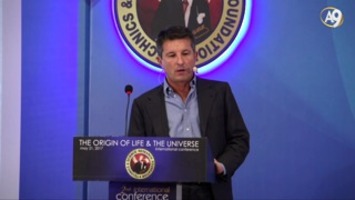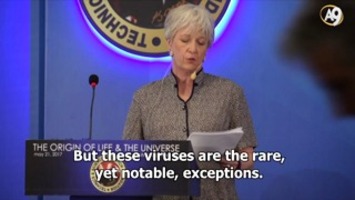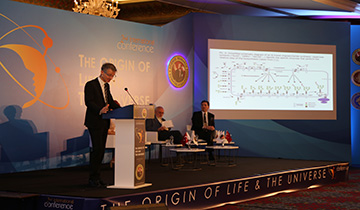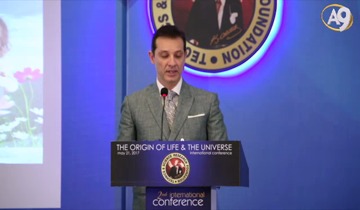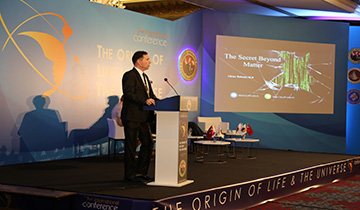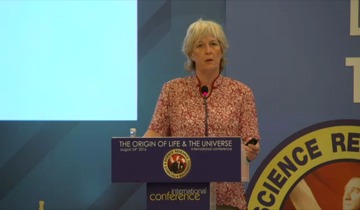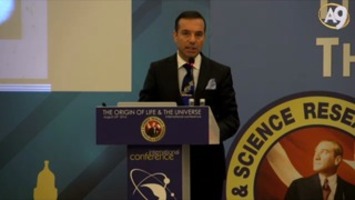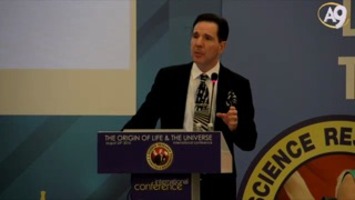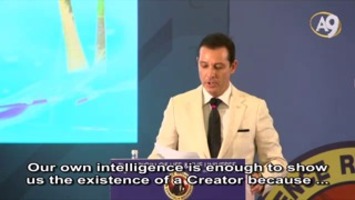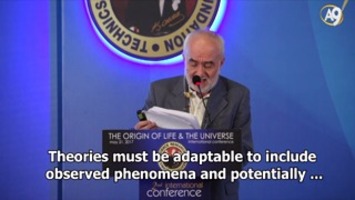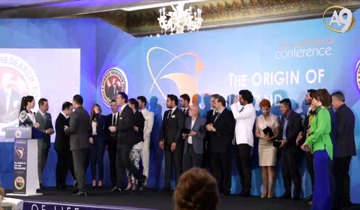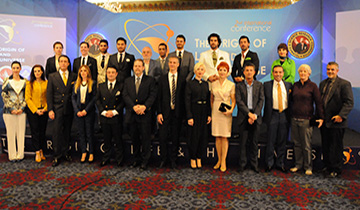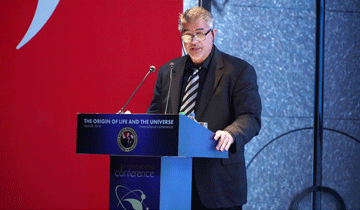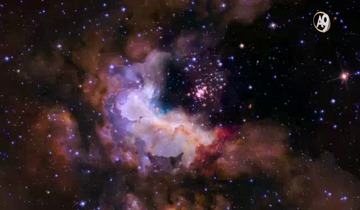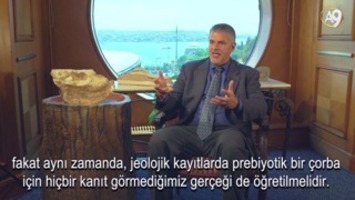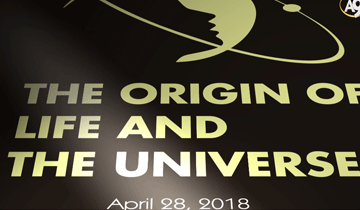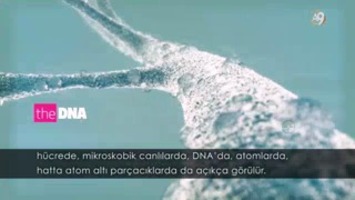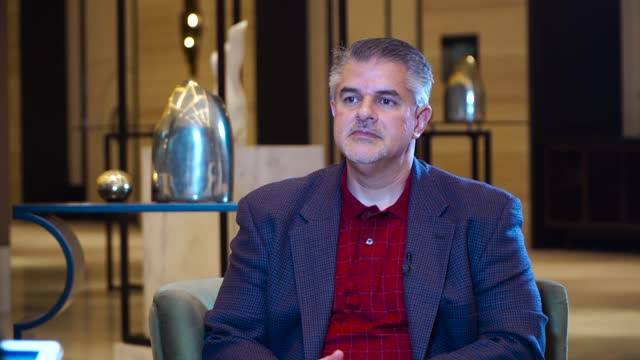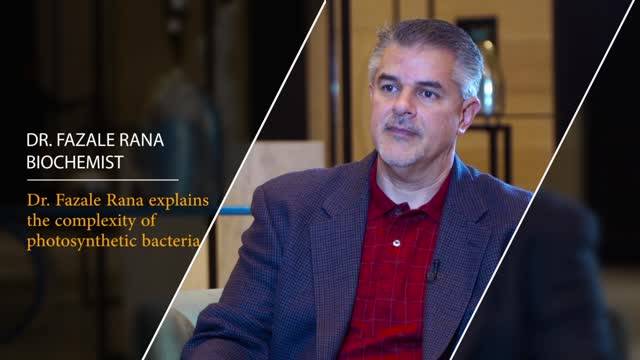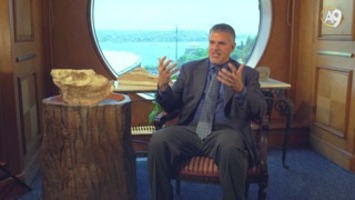Dr. Fazale Rana’s Lecture During the 2nd Intl Conf on the Origin of Life and the Universe (21.05.2017-Ritz Carlton)
I’d like to introduce our first speaker. He is Dr. Fazale Rana, from RTB. He is the vice president of RTB and is a biochemist. Dr. Rana usually works on genetics and synthetic biology and has written two books on the scientific evidence of creation, pursued post doctoral studies on cellular membrane. His articles have been published in various peer-reviewed journals including Biochemistry, Applied Spectroscopy –pardon my pronunciation- FEBS Letters, Journal of Microbiological ethods and Journal of Chemical Education. He has addressed audiences at over 500 universities, churches, and conferences around the world. Today Dr. Rana is going to tell us about the inspiring design of the DNA. Dr. Rana. Microphone is yours.
Goodmorning everybody!
It really is a pleasure and its an honour for me to be taking part in the second International Conference on the Origin of Life and the Origin of the Universe. I had the privilege of speaking at last year’s conference. And it was a wonderful opportunity so I am very grateful for the organizers to invite me to come back again this year. I considered again an honour.
It’s also exciting for me to be part of this Project its refreshing to share the stage with fellow Christians and Muslims, as we work together to demonstrate the scientific evidance for God’s existance, but also to identify the scientific challenges to the theory of evolution. This is very important because the theory of evolution is used to uphold, to support an atheistic world view. Because it is a reason of fashion I think to say if mechanism, if evolution can explain the origin and the history and the design of life then “What role is there for a Creator to play?”
Richard Dawkins in his book The Blind Watchmaker said these words: “Although atheism might have been logically tenable before Darwin, Darwin made it possible to be an intellectually fulfilled atheist.”
And in statements like these cause many people, I think to believe there is conflict between science and religion. But yet it was science that paid the way for my conviction that there was a Creator. When I was an undergradute student I was an agnostic. I didn’t know if God existed or not. I was more interested in becoming a biochemist. Doing every thing that I could prepare myself to go to graduate school to get a PhD in biochemistry.
As an undergraduate student, I was convinced that evolution was the way to explain the origin of life, the history of life and the design of life. Not because I examined the evidence and drew that conclusion, but because that was what my professors taught. The professors that I admired and respected and I accepted what they taught about the theory of evolution uncritically. I meet many students I speak on university campuses who were like me. They accept the theory of evolution because this is what their proffessors are teaching them. But things changed for me when I went graduate school. In graduate school one of the key things that is part of the education is teaching the students to think independently, to think critically to became scientist. To evaluate the evidence and draw conclusions regardless of what the expert say. And I began to ask questions I wouldn’t have asked as an undergraduate like where does life come from? How do scienteist explain the origin of life and I was prompt to ask that question. Because as I was worrying about biochemistry I came to appreciate the incredible elegance and sofistication the ingenuity of biochemical systems. So I wanted to know how do scientist explain were these systems come from?
And as I began to evaluate the different theories with chemical evolution for the origin of life I was shocked. I very quickly realized chemistry and physics could not produce the elegant designs of biochemical systems. And it was that recognisition coupled with the design of biochemical systems convinced me there had to be a mind. There had to be a Creator that brought that life into existance. And that prompt me to ask another questions. Such as “Who is that Creator? How do I relate to that Creator? I personally found answers to those questions in the Christian faith.
That was 30 years ago. And over the last three decades there have been advances in biochemistry insights into the origin of life problem that only make that conclusion even stronger. And what I like to do today is to give you just a glimp into some of the evidence, some of the reasons why I think that life must them from the work of a Creator and going to focus on DNA molecule. But instead of talking about the optimum and elegant design of DNA molecule which would be a lecture that would go on for hours, what I am going to do is to talk about something, I think fascinating about DNA.
DNA is so optimally designed that it is inspiring new technologies, new nanotechnologies. Specifically the development of new types of data storage media. It is leading the way in developing the next generation of computers. It is leading the way in developing nanoelectronics. This whole area of research is called bioinspiration in biomimetics were designs in biology are inspiring new technology. And I believe that this is actually further ground to develop new reasons to believe that there is a Creator that brought life came into existance.
Now to appreciate how DNA can inspire this type of technology we need to understand the role of DNA inside the cell. DNA is simplye an information storage system. And the information in DNA is digital information. And scientist believe that DNA actually is at the theoretical maximum turns the data storage capasity which is a remarkable property. And because of that property again DNA is inspiring newtechnology. DNA is optimally designed for its role is as a data storage system. And because of time constraint I can not give all the details of the structure of DNA how it contributes to its optimal data storage properties.
Every detail, every new ones aspect the DNA structure to contribute to this perticular property. And if people want more information I would recommend that they take a look my book The Cell’s Design, where there is a section that describes the optimal nature of DNA molecule. But for now what I want to do is simply turn our attention to the role DNA is playing and inspiring new technology. And the first place I want to look at DNA as a digital storage data system.
Now this is really interesting. Currently the world is facing a data storage crisis. You may not realize that, but we are facing a data storage crisis. There is currently 44 trillion megabytes of data in the World. Now to give you some contexts if there is 10 billion people on the planet it would mean each person would have to over 6000 CDs in order to store all that data. It is a mass amount of data. And in fact experts predict by 2040 if we continue at this pace of generating data there will not be enough high quality silicon in the world to make the data devices that we need. This is a real problem. This is where DNA comes into play.
Because one kilogram of DNA can store all the data that currently exist in the world. Again DNA operates at the theoratical maximum for data storage capasity. This is led scientists to contemplate using DNA as a digital storage media. And as a proof of a principle in 2012 a Harvard scientist George Church and his team actually encoded an entire book in the DNA molecule. This book was about 54.000 words and even included 11 jpeg images. And I would dare say that DNA can actually encode over works of Harun Yahya as well. It has that much data storage capasity.
One of the things that is really interesting that George Church and his team did is that they encoded the DNA in fragments. One part of the fragments was locater sequence like a page number on a page in a book and the other part contain data that allowed them to go into the DNA system. And actually retreated data not only page by page but skip around and locate data randomly from different pages. Really, really clever design.
DNA is so optimal again in its data storage capasity that actually serving as inspiration for technologist to look at developing other types of man made polymers that can serve as digital storage devices as well. So DNA clearly is an inspiration of molecule.
Computer scientist and molecular biologist have come to realize that the fundamental operations on DNA transcription, replication, DNA repair are literally functioning like computer systems. And this has inspired a whole new area of a new technology DNA computing and this is a picture of Leonard Adelman who is the father DNA computing. He is a scientist at the University of Southern California in the United States. DNA Computers are housed in little tiny test tubes this big. Yet they are more powerful than the most powerful super computer systems that we built today. And their power comes from two things. The data storage capasity of DNA and the opportunity to do vast of parallel operations simultaneously.
In fact researchers have been able to solve problems that you can not solve with silicon-based computers such as directed Hamilton Path problems and what is called the Knight problem. Now another interesting property of DNA is that it can function like a molecular scale wire. And this was the discovery made in the early 1990s by Jacqueline Barton, a chemist at Caltech. She discoverd that DNA has an unusual property a being able to conduct electrical current along the link of the DNA double helix. And in fact about about ten years later she and her team showed this is actually playing a critical role to detect damage to the DNA. And this diagram attampts to show that what you have this ‘surveillance’ proteins bind to DNA. Pick up that electron and dissociate from the DNA, migrates down the DNA. Once bound, they send an electron from an iron-sulfur redox center through the interior of the double helix, establishing a current through the DNA molecule. Once a surveillance protein loses an electron, it cannot dissociate from the DNA double helix.
Other surveillance proteins bound to the DNA, pick up the electrons from the DNA’s interior at their iron-sulfur redox center. When they do, they dissociate from the DNA, resuming their migration along the double helix. This process is repeated, over and over, again.
However, if damage has occurred to the DNA molecule, it will distort the double helix, interrupting the flow of electrons through its interior. When this happens, the surveillance proteins remain attached to the DNA, signaling the location of the damage to the DNA repair machinery. It is incredible a sophisticated system. Currently, nanotechnologists are exploring the use of DNA as nanowires, allowing them to build nanoelectronic devices. DNA would serve as the wire and there is even a thought this connection serve as a next generation a very sophisticated medical diagnostic equipment by using DNA’s wire properties. So again DNA is an inspiration of molecule inspiring at least three areas of technology that all relate to its digital data storage capasity. But I think DNA is doing more than inpiring technology.
A new way to argue for God’s existance and to apreciate that I like for us to spend a minute considiring of the works of the British natural theologian William Paley who in the late seventeen hundreds presented the world with Watch Maker argument for God’s existence in his book Natural Theology,
or Evidences of the Existence and Attributes of the Deity Collected from the Appearances of Nature. And this is how Paley introduces the Watch Maker argument: In crossing a heath, suppose I pitched my foot against a stone, and were asked how the stone came to be there: I might possibly answer, that, for any thing I knew to the contrary, it had lain there for ever. . . .
But suppose I had found a watch upon the ground, and it should be inquired how the watch happened to be in that place; I should hardly think of the answer which I had before given,—that, for any thing I knew, the watch might have always been there. Yet why should not this answer serve for the watch as well as for the stone? Why is it not as admissible in the second case, as in the first? For this reason, and for no other, viz. that, when we come to inspect the watch, we perceive (what we could not discover in the stone) that its several parts are framed and put together for a purpose, e.g. that they are so formed and adjusted as to produce motion. And that motion so regulated as to point out the hour of the day; that, if the different parts had been differently shaped from what they are . . . or placed after any other manner, or in any other order, than that in which they are placed, either no motion at all would have been carried on in the machine, or none which would have answered the use that is now served by it. . . . This mechanism being observed…the inference we think is inevitable, that the watch must have had a maker: that there must have existed, at some time, and at some place or other, an artificer or artificers who formed it for the purpose which we now find it actually to answer: who comprehended its construction, and designed its use.
For Paley, the characteristics of a watch and the complex interaction of its precision parts for time-keeping purposes implied the work of an intelligent designer. Paley asserted, by analogy, that just as a watch requires a watchmaker, so too, life requires a Creator, since organisms display a wide range of features characterized by the precise interplay of complex parts for specific purposes. According to the Watchmaker analogy, both watches and organisms display design. Watches are the product of a watchmaker. Therefore, organisms are the product of a Creator.
I think, it is straightforward to appreciate how advances in biochemistry allowed us to breathe new life into the Watchmaker Argument. As a case in point, considered DNA computers whether in the cell or in test tube are pinnacle of engineering achievement today. And we know the computers required a mind; in fact, many minds. And because we find computer systems operating within the cell, we can reasonably conclude that life requires a Divine Mind to account for its existence. In the similar words of Leonard Adelman the founder of DNA computing:
“The most important thing about DNA computing is that it shows that DNA molecules can do what we normally think only computers can do. This implies that Computer Science and Biology are closely related. That every living thing can be thought to be computing something, and that, sometimes, we can understand living things better by looking at them as computers.”
In conjunction with my presentation of the revitalized Watchmaker argument in my book The Cell’s Design, I proposed the Watchmaker prediction. I contend that many of the cell’s molecular systems currently go unrecognized as analogous to human designs because the corresponding technology has yet to be developed. That is, the Watchmaker argument may well become stronger in the future, and its conclusion more certain, as human technology advances. The possibility that advances in human technology will ultimately mirror the molecular technology that already exists as an integral part of biochemical systems, leads to the Watchmaker prediction. Which basicly is this:
As human designers develop new technologies, examples of these technologies, which previously went unrecognized, will become evident in the operation of the cell’s molecular systems.
In other words, if the Watchmaker analogy truly serves as evidence for the Creator’s existence, then it is reasonable to expect that life’s biochemical machinery anticipates human technological advances. And related to this idea the Watchmaker prediction can be dubbed the converse Watchmaker analogy. And the idea here is this that the biochemical systems in the cell is so well designed that they can acually inspire engineering that the systems in a cell so well designed inspire the development of new technologies. At some level, I find the converse Watchmaker argument more compelling than the classical Watchmaker analogy. It is remarkable to me that biological designs can inspire engineering efforts.
This is what Richard Dawkins says in his book The Blind Watchmaker:
“Natural selection, the blind, unconscious, automatic process which we now know is the explanation for the existence and apparently purposeful form of all life, has no purpose in mind. It has no mind and no mind's eye. It does not plan for the future. It has no vision, no foresight, no sight at all. If it can be said to play the role of watchmaker in nature, it is the blind watchmaker.”
Dawkins goes on to add:
“[Paley] had a proper reverence for the complexity of the living world, and he saw that it demands a very special kind of explanation. The only thing he got wrong was the explanation itself … The true explanation … had to wait for … Charles Darwin.”
But I believe that work in biomimetics and bioinspiration provide a response to the blind watchmaker challenge. And to understand that we need to think about the way evolutionary biologist think about evolution’s mechanisms. It’s unguided, it’s undirected, it’s blind. It all can do is to co-opt preexisting designs and cobble them together into new designs. That is the nature of evolunary process.
Most evolutionary biologists are quick to emphasize that evolutionary processes and pathways seldom yield perfect designs. Instead, most biological designs are flawed in some way. To be certain, most biologists would concede that natural selection has produced biological designs that are well adapted, but they would maintain that biological systems are not well designed. Why? Because evolutionary processes do not produce biological systems from scratch, but from preexisting systems that are co-opted through a process dubbed exaptation (by the late evolutionary biologist Stephen Jay Gould), and then modified by natural selection to produce new designs.
Once formed, these new structures can be fine-tuned and optimized through natural selection to produce well-adapted designs, but not well-designed systems. According to Ken Miller the famous biologist: Evolution . . . does not produce perfection.
The fact that every intermediate stage in the development of an organ must confer a selective advantage means that the simplest and most elegant design for an organ cannot always be produced by evolution. In fact, the hallmark of evolution is the modification of pre-existing structures. An evolved organism, in short, should show the tell-tale signs of this modification. But if biological systems, in effect, are kludged together, why would engineers and technologists turn to them for inspiration? If produced by evolutionary processes—even if these processes operated over the course of millions of years—biological systems should make unreliable muses for technology development. Does it make sense for engineers to rely on biological systems—historically contingent and exapted in their origin—to solve problems and inspire new technologies, much less build an entire subdiscipline of engineering around mimicking biological designs?Using biological designs to guide engineering efforts seems to be fundamentally incompatible with an evolutionary explanation for life’s origin, its design and history.
On the other hand, biomimetics and bioinspiration naturally flow out of an intelligent design/creation model approach to biology. Using biological systems to inspire engineering makes better sense if the designs come from the mind, come from a Creator.
As a scientist, as a Christian and as a believer, I find it remarkable how the Old and New Testaments anticipate scientific advance. When it comes to biomimetics and bioinspiration, Job 12:7-9 immediately comes to mind:
7“But ask the animals, and they will teach you, or the birds in the sky, and they will tell you;
8 or speak to the earth, and it will teach you,
or let the fish in the sea inform you.
9 Which of all these does not know
that the hand of the Lord has done this?”
And I just want to conlude and say:
13 “To God belong wisdom and power;
counsel and understanding are his.
Thank you very much.


